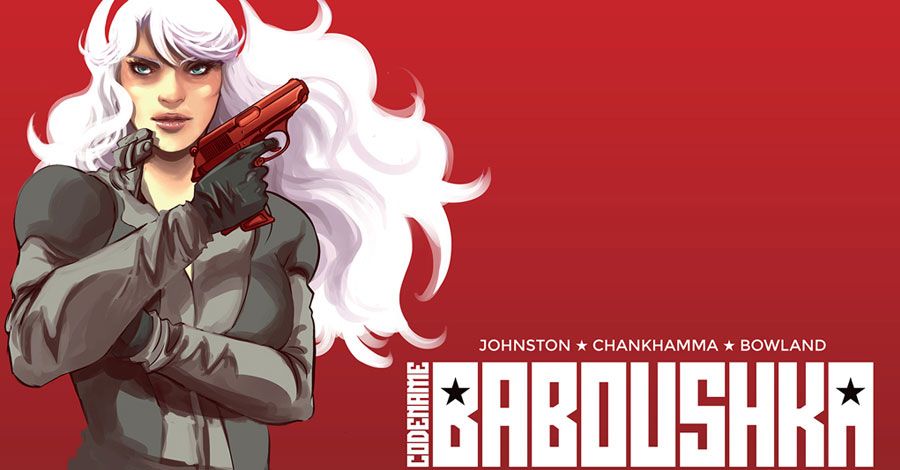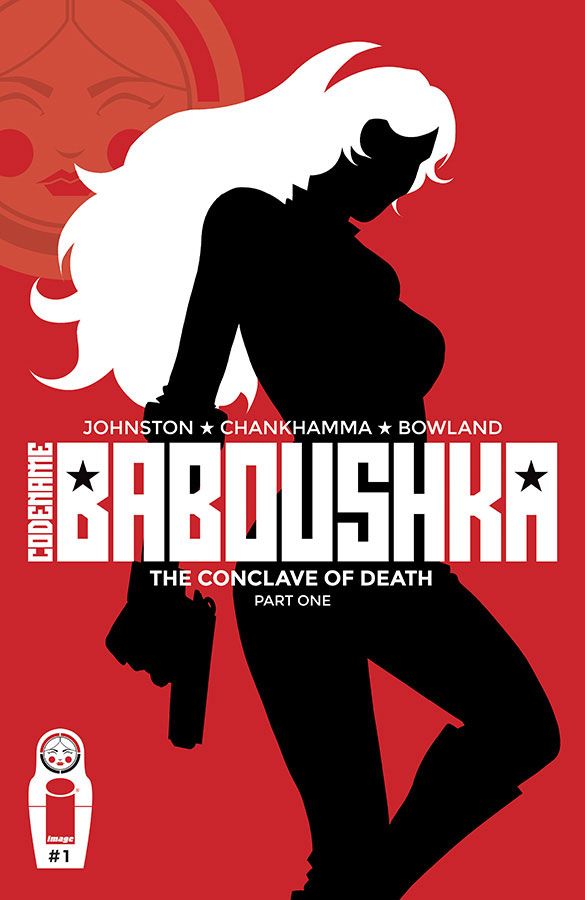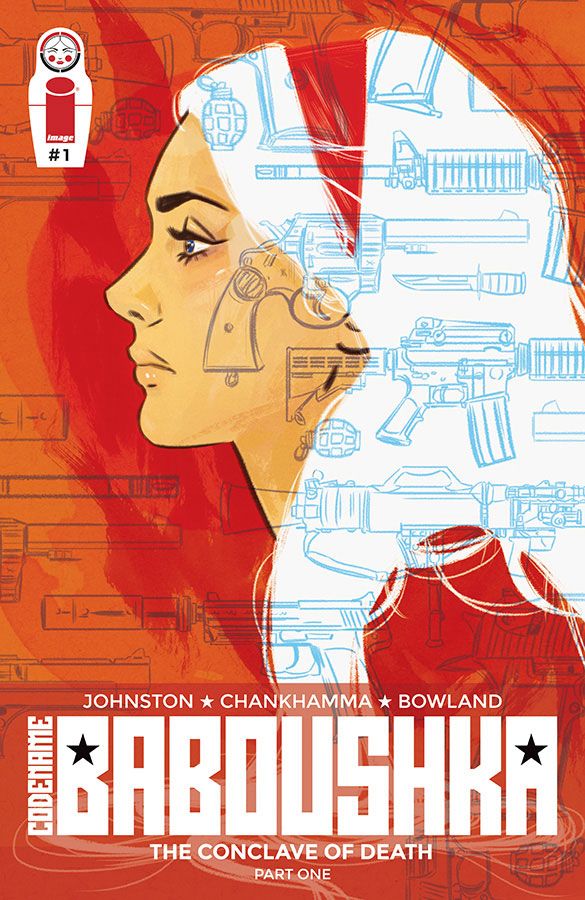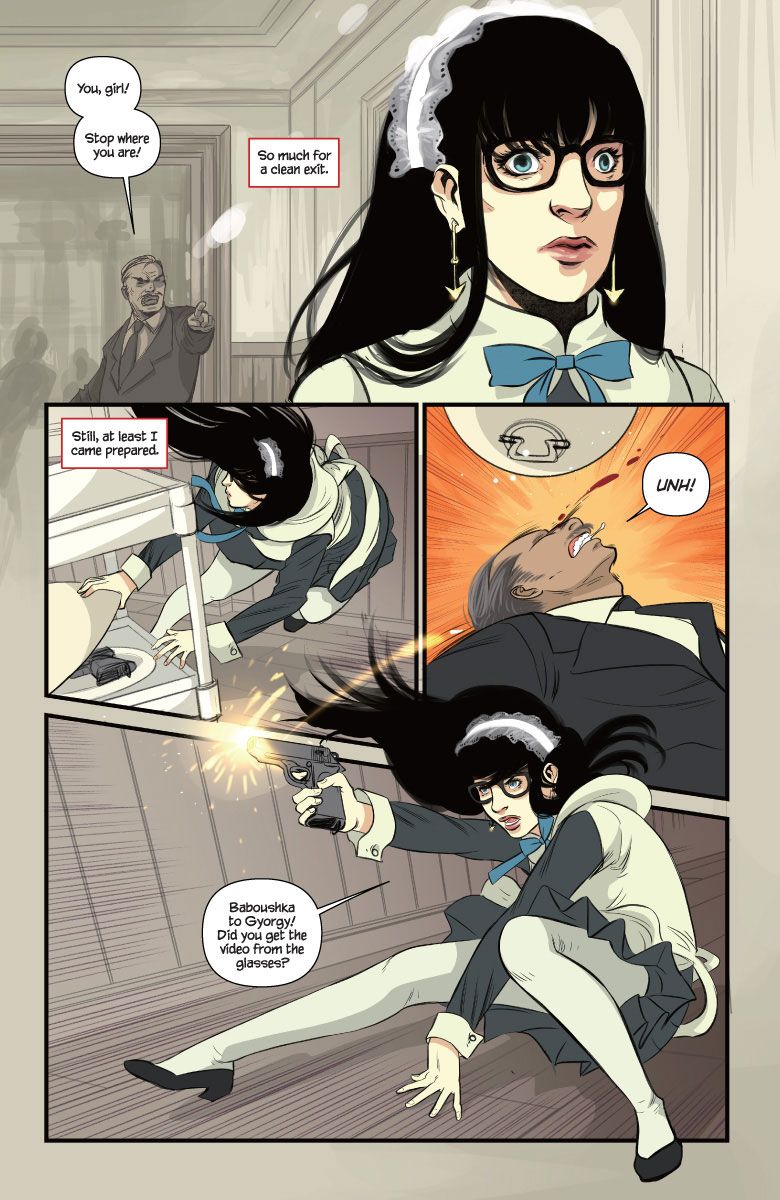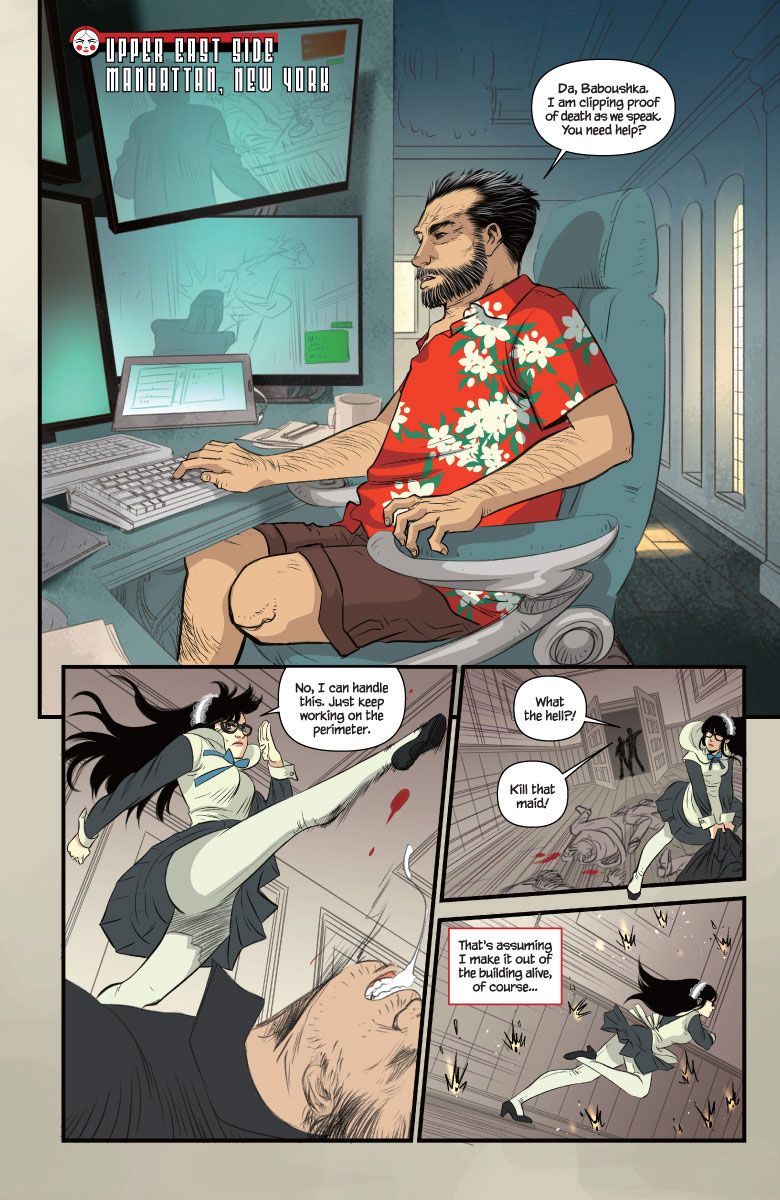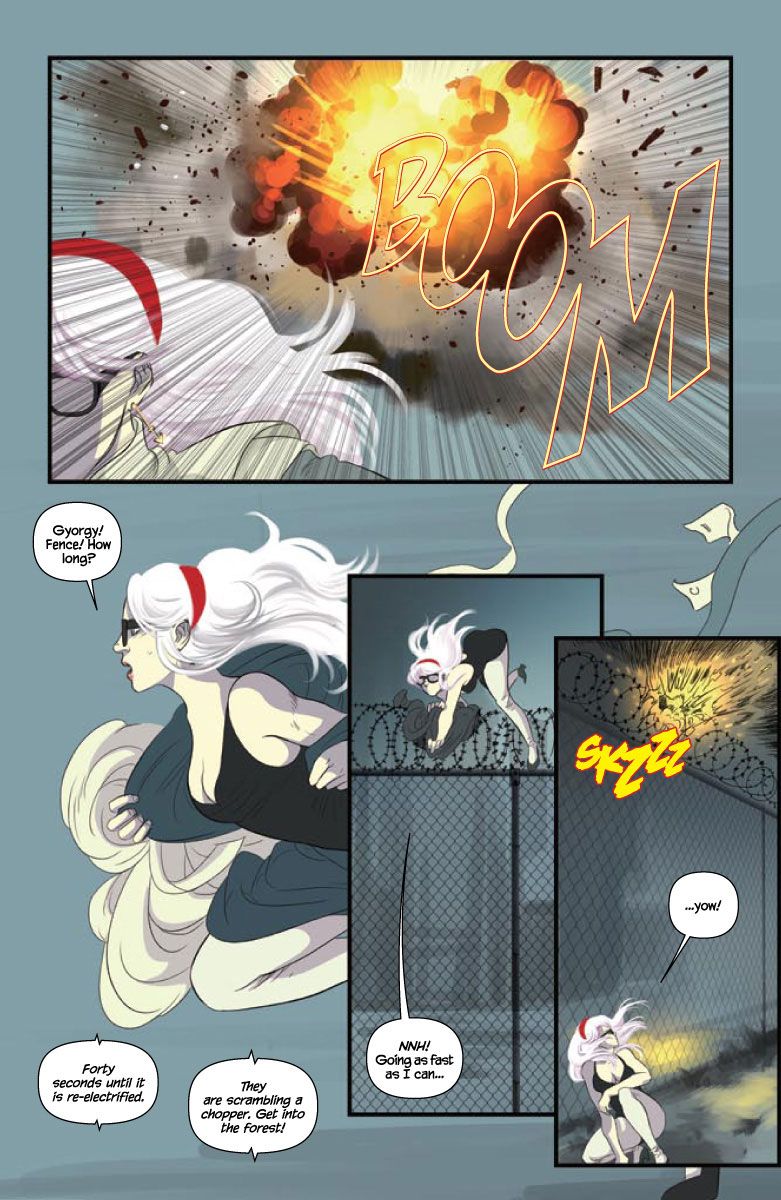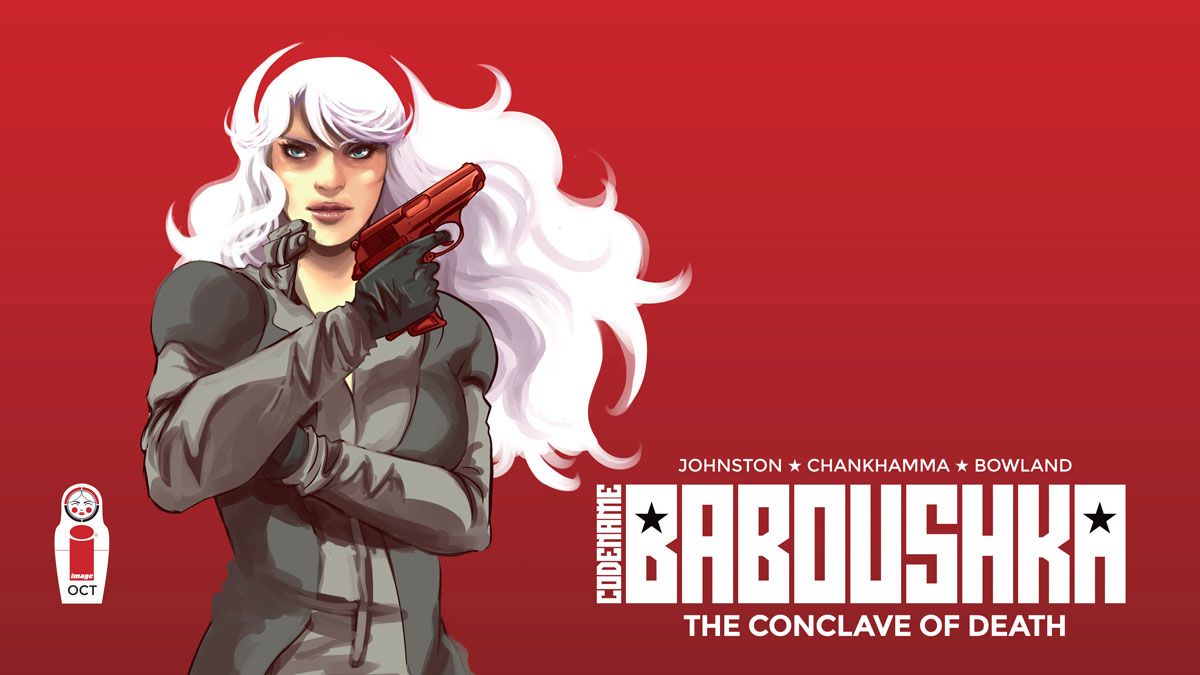Among the many exciting announcements at this year's Image Expo was Antony Johnston's spy thriller, "Codename Baboushka." Drawn by "The Fuse" colorist Shari Chankhamma, the first arc, "The Conclave of Death," kicks off in October and blends Johnston's signature world-building with hard-hitting action.
"Baboushka" follows former Russian mafia boss, Contessa Annika Malikova, who has fled her homeland in the wake of her organization's demise. She heads to New York with a trusted friend and cultivates a mysterious, glamorous persona in high society -- but her past catches up with her, and she is forced to choose between extradition and certain death, or taking ondangerous missions for a shady government network. Luckily, Annika is more than capable of jumping, shooting, punching and kicking her way through anything in her path. Like all of Johnston's protagonists, Annika is no one to mess with -- but it's incredibly fun watching people try.
Johnston spoke with CBR News about the series, expanding on the inspiring history of female spies, the power of his creative collaboration with Chakhamma and how he plans to subvert expectations of the spy genre as "Codename Baboushka" unfolds.
CBR News: Antony, the first issue of "Codename Baboushka" was an enormously fun read. What was your reaction when you saw the finished pages, fully lettered and complete?
Antony Johnston: My reaction was mainly excitement. It's always exciting to see the first issue of a new series become a reality, but especially with this one, because in many ways it's quite different to what I normally do.
So to see it all there on the page -- and realizing it works! -- put a big smile on my face, for sure.
The art is gorgeous. I'm a fan of Shari's work on "The Fuse" and I was excited to see her taking lead on art for this. What were the early conversations like when you were pitching "Codename Baboushka" to her? How long had you been working on it already?
I've been developing "Codename Baboushka" a few years, now. The spark came when I was re-watching "From Russian With Love" (one of my favorite Bond movies) back in 2012, and realized I wanted to see a version of that story from Tatiana Romanova's point of view.
That got me thinking about female spies, action leads and historical spy characters like Modesty Blaise and Emma Peel. They were groundbreaking characters in their time, and it's a sad state of affairs that almost half a century later, female action characters like them are still regarded as unusual and innovative.
There's also a serious dearth of leading female action characters in comics, especially outside the superhero universes. It is only really in the last several years that this imbalance is being seriously addressed. We're still nowhere near any kind of equilibrium.
I wanted to create a character who could be that leading female action hero, a fighter and survivor who was in charge of her own destiny. A character that could endure, and find herself in any number of stories and adventures. Someone with an iconic look, an interesting and shady history -- and a very bad attitude.
That's Baboushka.
But as comic fans know, it takes the right artist at the right time to really bring a concept to life. Like most people, I only knew Shari as an amazing colorist, from her work on "The Fuse" and "Sheltered." But it turns out she's also an awesome artist, with graphic novels, web strips and more to her name. I only found out myself when she wrote to tell me she was enjoying working on "The Fuse" and showed me some of her work in case I needed an artist for a suitable project -- and when I saw it, I realized she was just right for "Codename Baboushka."
Shari's work is modern and energetic, a mixture of manga influences and American storytelling that comes from her unusual background; she's a Thai native, but she reads, loves and works in the US market. She has a great eye for character, draws some downright sexy women and men, plus -- because she's such a great colorist -- readers are getting a full-on Shari art experience, from layouts through to final colors. It all looks fantastic.
When you announced the book at Image Expo, you described it as being what readers have come to expect from you, only with the action ramped up. The rhythm of this first issue was so well done and visually exciting -- how are you and Shari pacing the action in the story for maximum impact? I'm particularly curious to know how the paneling is working -- are you writing each panel, or giving her more control over that bit?
I'm a fairly traditional comic writer. I write full script, with enough detail that -- in theory -- an artist could draw exactly what I describe, and everything would work fine.
But I also love the style of collaboration that's so unique to comics, and I always encourage artists to do what they feel works best for the story. Whether that is experimenting with page layouts, adding or removing panels from a sequence, whatever. After all, I'm not an artist; I can visualize something in my mind, but if they can come up with a better way to present it, I'm all for that.
In "Codename Baboushka," you'll see this reflected in some of the panel breakdowns; for example, in the restaurant scene where Baboushka jams the EON agents' earpieces, or where the butler realizes Goran Sablic is dead, Shari's added small panels to zoom in on important parts of the images, and make sure the reader knows what's happening.
I thought that was brilliant, and encouraged Shari to do more of those "zoom circles" in other places where she felt they'd fit -- I even asked for them specifically in some later issues.
So that's a small thing, but it's just one instance where it's fun to defer to an artist like Shari, to whom something like that comes naturally. The end result is a great comic that neither of us could make ourselves, and that's what really matters.
British culture has a long creative relationship to spy fiction -- what is your history with the genre? And what elements are you adding to it in "Baboushka?"
We do, and I think much of it stems from being so close to the Iron Curtain during the Cold War. Not that we didn't have spies before the 1960s, of course. But it was that period, growing out of the Resistance movement and SEO work during WWII, that really seemed to cement espionage in the British psyche, and so much great fiction grew out of that.
As for my history with it, it's generally been on the darker side of tradecraft -- I love John Le Carre, Len Deighton and, of course, Greg Rucka. That's been reflected in my own work for a long time, with stuff like "The Coldest City," and my arc of "Queen & Country: Declassified."
But I also love a bit of pulpy action: James Bond, Black Widow, Modesty Blaise and The Avengers -- Steed & Mrs Peel, that is.
Then there's the teen spy Alex Rider books, which I've been adapting to graphic novels for a while. They're very pulpy, full of high adventure, gadgets, betrayal and double-crosses.
I wanted to scratch that itch more, and this is the perfect place to do it. Baboushka is a big-action modern pulp character, with adventures packed with guns, explosions and martial arts, and I'm having a blast chronicling her exploits.
Baboushka is, of course, Russian noble Contessa Annika Malikova, a mafia boss that fled her homeland for New York. What will you be exploring with her in the first arc? Will we see any of her history and rise to power?
We won't see it directly, but we'll get hints about her past and what happened. The Contessa's history, her rise and fall as Baboushka and so on, is a story that will be told in the fullness of time, through future adventures. And there are plenty of surprises in store, even on that front.
Spy novels have long been a quite masculine space, with men at the center of these stories afforded autonomy, power and freedom. What opportunities does having Annika as your protagonist afford you?
There are two main angles of attack, here, that come with having a female protagonist in a role like this.
First, the chance to show a kick-ass woman doing what's traditionally thought of as a man's job -- and to show her doing it well, with no gender disadvantage or handicap. That's still a rare thing, in all fiction, and especially in comics. And sure, I personally enjoy it -- I love reading stories about women like that -- but it's also a matter of representation, both to show female readers characters they can relate to, and to show male readers that such characters shouldn't be unusual.
Conversely, there's also the opportunity to subvert a lot of expectations, and play on the notion of how a woman in this role might approach it differently. In the very first issue, she disguises herself as a maid, because who ever pays any attention to the maid? In issue #2, she uses her femininity to both gain access to secrets a man would never get, and to outwit macho thugs who assume a mere woman couldn't possibly be a threat.
So it's a lot of fun, writing a character like this. It gives me the opportunity to explore modern pulp action in a way that a vanilla male character simply wouldn't.
Russia has a history of powerful noble women, notably Catherine the Great -- how does Annika's heritage inform her world view? What does her culture mean to her identity?
The Contessa's background isn't what you'd call a "normal" noble upbringing!
Contessa Annika Malikova is the last scion of the House of Malikov, an old noble Russian line. They fled Russia after the October Revolution to live in Switzerland, intending to return when the Bolsheviks collapsed.
Of course, the Bolsheviks didn't collapse, and the Malikovs soon frittered all their money away. By the time Annika was born, they were penniless.
When her family died in mysterious circumstances, Annika -- then just a teenage girl -- took matters into her own hands. She returned to Moscow, determined to re-make her fortune by any means necessary. She doesn't talk about what happened, exactly, but it didn't take long for her to settle on a life of crime.
She adopted the nickname Baboushka, became a gang boss in the Russian mafiya, and quickly built a criminal empire.
(Exactly why she took the term for "grandmother" as her nickname is a whole other story, by the way.)
Baboushka was soon a renowned crime lord, a ruthless killer feared throughout Moscow -- until the other mafiya bosses joined forces against her, and forced her to flee the country with her second-in-command, Gyorgy Gyorgyov.
Three years ago, they wound up in the USA under their civilian names, claiming political asylum. But while three years is a long time in the criminal underworld, it's not long enough for those wounds to heal. Annika may be putting on a brave face for the Americans, but inside she's still bitter and hurt at what she lost -- what was taken from her -- and she secretly longs for a bit of action.
Of course, the blackmail that EON have over her isn't quite what she had in mind! But it becomes clear throughout this first story that she's quite enjoying her return from premature retirement, whatever the circumstances.
You include a fantastic essay by Maya Rodale in the backmatter of the first issue, discussing the history of action heroines. How did you connect with her? And will these essays be a common feature in "Baboushka?"
I met Maya through my podcast, "Unjustly Maligned" -- she's a bestselling author of romance novels, and I invited her on to defend the genre. It's one of my favorite episodes, because she has some great thoughts and arguments about how romance is, well, unjustly maligned. And comic readers might be surprised to learn just how many similarities our own industry and culture has with romance novels!
I knew I wanted "Codename Baboushka" to include backmatter essays from feminist writers and critics, so after the show I asked Maya about contributing. I had no idea if she'd go for it, but to my surprise she read issue #1 and promptly wrote a great piece about female protagonists in literary history. It's pretty awesome.
But that's just the first issue; every issue in "The Conclave of Death" will feature another essay. As well as Maya, we have Danielle Henderson, Leigh Alexander, Katy Rex, and I'm currently putting the thumbscrews on Gail Simone... so *that's* pretty awesome, too.
You've also got some incredibly talented artists doing variant covers -- Leila Del Duca, Tula Lotay, Kate Leth, Annie Wu. How did you select them? And will this be the plan for future arcs as well?
That was an idea I had when discussing the book with Image publisher Eric Stephenson. I knew I wanted to do the two alternate styles of cover, the regular silhouettes and the variant "art covers," for each issue. I already had Tula Lotay in mind for #1 -- I've known her for a long time, and love her work.
Eric picked up on the idea, and suggested that because of the strong feminist attitude of the book, it would be really cool to get an all-female artist line-up for those alternate covers. He was right, it's an awesome idea!
We made a list of artists we'd love to see drawing Baboushka. Then we asked some friends to make similar lists; and it turned out they were almost identical, so we knew we were onto something. Then it was a matter of just going down the list and asking people.
For "The Conclave of Death" we have Tula, Annie Wu, Leila del Duca, Tess Fowler and Kate Leth, all doing amazing covers for us. It's been great, and we definitely plan to do it again with future stories.
And how are things going with "The Fuse?" I'm excited to see what's going on with another of your white-haired women!
Heh. I'm glad you noticed that, because believe it or not, I totally didn't until someone else pointed it out to me...! But Baboushka's white hair is very much a part of her character and background, so I figured what the hell. If I'm going to be stereotyped for anything, "kick-ass white-haired Russian women" isn't bad.
"The Fuse" #13 kicks off "Perihelion," a new story arc where we're switching things up a little.
In previous arcs, we followed Klem and Ralph through a single murder case, over the course of several days. But this time we're following the events of a single day -- perihelion itself, when the Fuse is closest to the sun and everyone goes a little crazy -- through several different cases. Of course, some of those cases will be still be murder mysteries.
It's pretty exciting, and we think it's our best work on the book so far, so we hope everyone else enjoys it!

